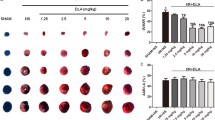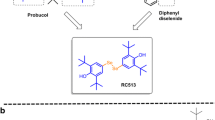Abstract
L-Propionylcarnitine, a propionyl ester of L-carnitine, increases the intracellular pool of L-carnitine. It exhibits a high affinity for the enzyme carnitine acetyltransferase (CAT) and, thus, is readily converted into propionyl-coenzyme A and free carnitine.
It has been reported that L-propionylcarnitine possesses a protective action against heart ischemia–reperfusion injury; however, the antioxidant mechanism is not yet clear. L-Propionylcarnitine might reduce the hydroxyl radical production in the Fenton system, by chelating the iron required for the generation of hydroxyl radicals. To obtain a better insight into the antiradical mechanism of L-propionylcarnitine, the present research analyzed the superoxide scavenging capacity of L-propionylcarnitine and its effect on linoleic acid peroxidation. In addition, the effect of L-propionylcarnitine against DNA cleavage was estimated using pBR322 plasmid. We found that L-propionylcarnitine showed a dose-dependent free-radical scavenging activity. In fact, it was able to scavenge superoxide anion, to inhibit the lipoperoxidation of linoleic acid, and to protect pBR322 DNA from cleavage induced by H2O2 UV-photolysis.
Similar content being viewed by others
References
Akaike T, Salo K, Ijiri S, et al. Bactericidal activity of alkyl peroxyl radicals generated by heme-iron-catalyzed decomposition of organic peroxides. Arch Biochem Biophys. 1992; 294:55-63.
Alessio HM. Execise-induced oxidative stress. Med Sci Sports Exerc. 1993;25:218-24.
Alessio HM, Cutler RG. Evidence that DNA damage and repair cycle activity increases following a marathon race. Med Sci Sports Exerc. 1990;22:S126-30.
Alessio HM, Goldfarb A, Cutler RG. MDA content increases in fast-and slow-twitch skeletal muscle with intensity of exercise in a rat. Am J Physiol. 1988;255:C874-7.
Arduini A, Fernandez E, Pallini R, et al. Effect of propionyl-l-carnitine on rat spinal cord ischaemia and post-ischaemic reperfusion injury. Free Radic Biol Med. 1990;10:325-32.
Bertelli A, Conte A, Ronca G, Segnini D, Yu G. Protective e¡ect of propionyl-l-carnitine against peroxidative damage to arterial endothelium membranes. Int J Tissue React. 1991;XIII:41-3.
Bieber LL. Carnitine. Annu Rev Biochem. 1988;57:261-83.
Bonina F, Saija A, Tomaino A, Lo Cascio R, Rapisarda P, Dederen JC. In vitro antioxidant activity and in vivo photo-protective effect of a red orange extract. Int J Cosmetic Sci. 1998;20:331-42.
Bremer J. Carnitine-metabolism and function. Physiol Res. 1983;63:1420-80.
Chiddo A, Gaglione A, Musci S, et al. Hemodynamic study of intravenous propionyl-l-carnitine in patients with ischemic heart disease and normal left ventricular function. Cardiovasc Drugs Ther. 1991;5:107-11.
Davies KJA, Quintanilha AT, Brooks GA, Packer L. Free radicals and tissue damage produced by exercise. Biochem Biophys Res Commun. 1982;107:1198-205.
Ferrari R, Ceconi C, Curello S, Pasini E, Visioli O. Protective effect of propionyl-l-carnitine against ischaemia and reperfusion-damage. Mol Cell Biochem. 1989;88:161-8.
Green H, Plyley M, Smith D, Kile J. Extreme endurance training and fiber type adaptation in rat diaphragm. J Appl Physiol. 1989;66:1914-20.
Gutteridge JM, Halliwell B. The measurement and mechanism of lipid peroxidation in biological systems. Trends Biochem Sci. 1990;15:129-35.
Packer L, Valenza M, Serbinova E, Starke-Reed, Frost K, Kagan V. Free radical scavenging is involved in the protective effect of l-propionyl-carnitine against ischemia-reperfusion injury of heart. Arch Biochem Biophys. 1991;288:533-7.
Paoletti F, Aldinucci D, Mocali A, Caparrini A. A sensitive spectrophotometric method for the determination of super-oxide dismutase activity in tissue extracts. Anal Biochem. 1986;154:536-41.
Paulson DJ, Trazler J, Schmidt M, Noonan J, Shug AL. Protection of the ischaemic myocardium by l-propionyl carnitine: e¡ects on the recovery of cardiac output after ischaemia and reperfusion, carnitine transport and fatty acid oxidation. Cardiovasc Res. 1986;20:536-41.
Radak Z, Asano K, Inoue M, et al. Superoxide dismutase derivative reduces oxidative damage in skeletal muscle of rats during exhaustive exercise. J Appl Physiol. 1995;79: 129-35.
Reznick AZ, Kagan VE, Ramsey R, et al. Antiradical effects in l-propionyl carnitine protection of the heart against ischemia-reperfusion injury: the possible role of iron chelation. Arch Biochem Biophys. 1992;296:394-401.
Shug A, Paulson D, Subramanian R, Regitz V. Protective e¡ects of propionyl-l-carnitine during ischemia and reperfusion. Cardiovasc Drugs Ther. 1991;1:77-83.
Siliprandi N, Sartorelli L, Ciman M, Di Lisa F. Carnitine: metabolism and clinical chemistry. Clin Chim Acta. 1989; 183:3-12.
Subramanian R, Plehn S, Noonan J, Schmidt M, Shug AL. Free radical-mediated damage during myocardial ischemia and protection by carnitine esters. Z Kardiol. 1987;76:41-5.
Stocks J, Dormandy TL. The autoxidation of human red cell lipids induced by hydrogen peroxide. Br J Haematol. 1971; 20:95-111.
Wiseman LR, Brogden RN. Propionyl-l-carnitine. Drugs Aging. 1988;12:243-8.
Rights and permissions
About this article
Cite this article
Vanella, A., Russo, A., Acquaviva, R. et al. L-Propionyl-carnitine as superoxide scavenger, antioxidant, and DNA cleavage protector. Cell Biol Toxicol 16, 99–104 (2000). https://doi.org/10.1023/A:1007638025856
Issue Date:
DOI: https://doi.org/10.1023/A:1007638025856




